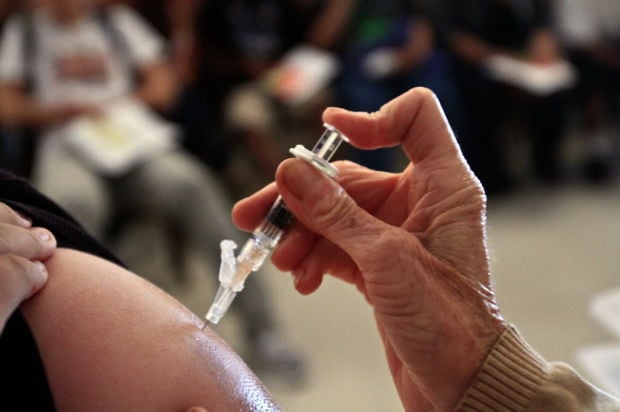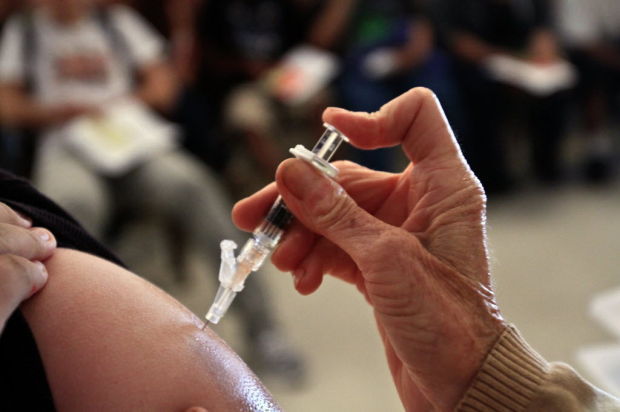More parents of local preschoolers are opting their children out of vaccines against infectious diseases like measles, meningitis and whooping cough.
The percentage of preschoolers statewide with non-medical vaccine exemptions has quadrupled since 2000, new state data shows. The higher the exemption rate, the more likely a disease can “wiggle its way into a group,” says Dr. Karen Lewis, who is medical director of the state health department’s Arizona Immunization Program.
The rise in exemption rates reflects the growth nationwide in parents who are more afraid of vaccines than of the serious diseases they prevent.
As with other age groups, the vaccine exemption rate of preschoolers in Arizona remains relatively small — 4.1 percent. But it is a significant population because of its growth.
The new data says Pima County’s rate of non-medical exemptions from preschool is 3.5 percent, which is lower than the state average but has also grown. Most Pima County preschools have what is considered a safe percentage of vaccinated children, but a handful are below what health experts say is required for “herd immunity.”
Herd immunity is the level at which enough people are vaccinated that an isolated case of infectious disease will not morph into a full-blown outbreak. For most vaccines, herd immunity occurs when 90 percent or more of a particular group, such as a class of children, are vaccinated. For measles it’s usually considered 95 percent since the disease is so contagious.
More than half of the children enrolled at the Waldorf preschool in Tucson last school year had non-medical exemptions from getting vaccinated, the state data shows. The state provided the Star with school-by-school vaccination rates for preschools, but withheld data from those with fewer than 20 children.
Having unimmunized children in preschool settings is particularly worrisome since they are at a high risk of spreading infection to one another and to the rest of the community. They have less control over their saliva and bowel movements, and they’re more likely to put things in their mouths, thus increasing the possibility of disease transmission, Lewis said.
“I think the vast majority of parents are actually unaware of the fact that this is increasing,” said Beth Jacobs, an associate professor of epidemiology at the Mel and Enid Zuckerman College of Public Health at the University of Arizona.
“It seems to keep going up and up and up. But is there a point where we have saturated the group of people who are inclined to do this (not vaccinate)? I don’t know the answer to that,” said Jacobs, who co-authored a 2012 study about vaccine exemption rates in Arizona kindergartners along with Kacey C. Ernst, a UA assistant professor of epidemiology.
Rates declining
The UA study found that people who choose not to vaccinate their children were most often upper middle class, educated, and non-minorities. Based on their results, the state revamped its exemption forms and published a resource guide to vaccinations for schools and childcare centers.
Yet vaccination rates have continued to decline in Arizona, and non-medical exemption rates have continued to climb.
Children who can’t be vaccinated because of illnesses like cancer, or whose immune systems are suppressed, depend on those around them to be protected. Public health officials say parents should feel some sense of responsibility to those children, not just to their own.
The Tucson Waldorf school, with an enrollment of 40 students, was among a handful of local preschools with vaccination rates low enough to put the children at risk for dangerous vaccine-preventable diseases during the 2013-14 school year.
“I wouldn’t send my child to a school with 55 percent coverage of some of these vaccines,” said Jacobs, who reviewed the Pima County preschool data at the Star’s request. “Overall the rates (for Pima County) look pretty good, but it is worrisome that they are concentrated in specific preschools.”
Tucson Waldorf enrollment director Rebecca Briamonte said some parents sign an exemption form but are not skipping vaccines — they just have their children on a delayed schedule. She said the school attracts a diverse group of parents, including many with an interest in alternative health and there are parents who choose not to vaccinate.
Yet some of those parents will vaccinate their children when they are older or about to travel internationally, she said.
Jacobs said younger children often have siblings who are infants too young to be vaccinated. That’s particularly dangerous when it comes to whooping cough, which often strikes in infants 6 months of age or younger and can have tragic consequences, including death, she said.
law allows exemptions
At the parent cooperative Tucson Community School, 2109 E. Hedrick Drive, and the Downtown Community School in Barrio Viejo, fewer than 75 percent of enrolled children had at least one dose of measles vaccine last year. The schools were also both below herd immunity for pertussis (whooping cough).
Anne Rumps, who just started her job as director of the Tucson Community School, said last week that she was surprised at the high proportion of children at the school with non-medical vaccine exemptions. The rate is much higher than what she saw in the public school system, where she previously worked.
“Every parent, acting with the highest welfare of their child in mind, must make that very personal and health-impacting decision for themselves. We respect each parent’s right to decide what is in his or her child’s best interest,” Rumps said.
She noted that the school is vigilant about hand washing, which goes a long way toward disease prevention. At the same time, she wants to understand the reason for the school’s high exemption rate, and to make sure parents know that unvaccinated children could miss out on a lot of school in the event of an outbreak.
“I’d be the first to say don’t vaccinate if the science supports that. But I haven’t been convinced,” she added. “As the parents of three, my husband and I decided the benefits far outweighed the risks of immunization.”
Sometimes parents who choose not to vaccinate their children are friends with one another, which is possibly why Desert Spring Children’s Center in the university area had a higher than average non-medical exemption rate last school year, director Sara Van Slyke said. She could think of only four families this school year who signed non-medical vaccine exemptions.
Like most other preschool directors contacted by the Star, Van Slyke was deeply concerned about vaccination rates, but noted that state law allows parents to choose non-medical exemptions. She stressed that in the event of an outbreak, unvaccinated children would have to stay home from school.
The risks for outbreaks have been increasing in the U.S., particularly for measles, which the U.S. Centers for Disease Control and Prevention says is at a 20-year high in the U.S. Ninety percent of U.S. residents who have been infected are either unvaccinated or their vaccination status was not known, federal officials say.
Before the measles vaccination program started in 1963, about 3 million to 4 million people got measles each year in the U.S. Of them, 400 to 500 died, 48,000 were hospitalized and 1,000 developed chronic disability from measles encephalitis, CDC officials say.
Diphtheria skipped
The new outbreaks are being driven by unvaccinated people who get measles in other countries, bring it back to the U.S., and spread it to others in communities where many people are not vaccinated, federal data shows.
Whooping cough is also on the rise. In Pima County, two whooping cough outbreaks in the Vail Unified School District last year meant unvaccinated students had to stay home from school for a minimum of two weeks. The vaccine to prevent whooping cough is called DTaP — diphtheria, tetanus and pertussis.
Ten of the 214 state licensed childcare facilities in Pima County had pertussis vaccination rates below the 90 percent level considered safe against an outbreak. Those preschools were mostly in the central Tucson area.
“It seems we are being hard on schools when we say 85 percent is not good enough, but we need 90 to 93 percent for herd immunity,” Pima County Health Department Director Dr. Francisco Garcia said.
The pertussis vaccine is not 100 percent effective, which is an argument some people use to say why they don’t get it.
“What worries me is that if people skip it, diphtheria is also a component of that vaccine,” epidemiology professor Jacobs said. “And people may pooh-pooh pertussis, although I disagree with that, but diphtheria is an absolutely horrifying disease.”
Diphtheria, an upper-respiratory disease, is caused by bacteria that produce a deadly toxin. Prior to widespread immunizations and better living conditions it killed about 13,000 people in the U.S. per year. Jacobs notes that like other dangerous diseases, it’s just a plane ride away.
Thirteen Pima County preschools were below 90 percent vaccination rates against three or more doses of Haemophilus influenzae Type b (Hib), which protects against meningitis, pneumonia, and a severe throat infection called epiglottitis. The vaccine is recommended for all children younger than 5 years old in the U.S, and it is usually given to infants starting at 2 months.
“When I was first a pediatrician we did not have the vaccination against haemophilus Type b, and there would be about 20,000 cases of invasive Hib throughout the country. Half of those would be meningitis,” said Lewis, of the state’s immunization program.
“I got very good at doing spinal taps on 1-, 2- and 3-month-old infants who would have this devastating meningitis causing brain damage, seizure, death. Since we have had the Hib vaccine, resident doctors hardly see Hib infections at all. It disappeared off the radar.”
Lewis’ advice to parents is simple — vaccines are good, disease is bad. Like other government health officials, Lewis says that adverse effects from vaccines are extremely rare and that the benefits far outweigh the risks. That’s also what the scientific evidence says.
The most recent state data on vaccination rates showed exemptions are also on the rise among Arizona kindergarten and sixth-grade students. Nearly 5 percent of kindergarten students had vaccine exemptions in the last school year, more than double what it was in 2004.
Among kindergartners, exemptions were much higher in charter and private schools than in public schools. Of kindergartners enrolled in charter schools, 9.1 percent had been exempted from immunizations by their parents, the state data shows.
“If you talk to my grandmother, who had a neighbor on each side of her die of diphtheria when she was a child, she thinks this is just ludicrous not to get vaccinations,” Jacobs said. “But she’s 97. We just don’t know what it looks like anymore. And it can come back. It is scary how fast some of these could come back.”





